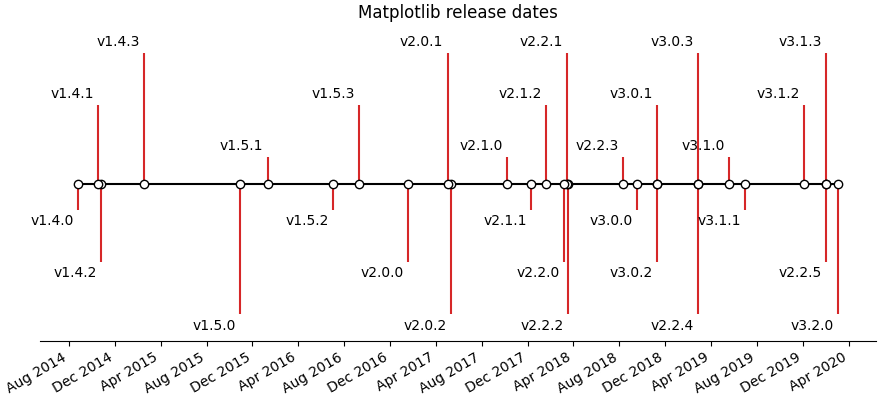Note
Click here to download the full example code
Creating a timeline with lines, dates, and text¶
How to create a simple timeline using Matplotlib release dates.
Timelines can be created with a collection of dates and text. In this example, we show how to create a simple timeline using the dates for recent releases of Matplotlib. First, we'll pull the data from GitHub.
import matplotlib.pyplot as plt
import numpy as np
import matplotlib.dates as mdates
from datetime import datetime
try:
# Try to fetch a list of Matplotlib releases and their dates
# from https://api.github.com/repos/matplotlib/matplotlib/releases
import urllib.request
import json
url = 'https://api.github.com/repos/matplotlib/matplotlib/releases'
url += '?per_page=100'
data = json.loads(urllib.request.urlopen(url, timeout=.4).read().decode())
dates = []
names = []
for item in data:
if 'rc' not in item['tag_name'] and 'b' not in item['tag_name']:
dates.append(item['published_at'].split("T")[0])
names.append(item['tag_name'])
# Convert date strings (e.g. 2014-10-18) to datetime
dates = [datetime.strptime(d, "%Y-%m-%d") for d in dates]
except Exception:
# In case the above fails, e.g. because of missing internet connection
# use the following lists as fallback.
names = ['v2.2.4', 'v3.0.3', 'v3.0.2', 'v3.0.1', 'v3.0.0', 'v2.2.3',
'v2.2.2', 'v2.2.1', 'v2.2.0', 'v2.1.2', 'v2.1.1', 'v2.1.0',
'v2.0.2', 'v2.0.1', 'v2.0.0', 'v1.5.3', 'v1.5.2', 'v1.5.1',
'v1.5.0', 'v1.4.3', 'v1.4.2', 'v1.4.1', 'v1.4.0']
dates = ['2019-02-26', '2019-02-26', '2018-11-10', '2018-11-10',
'2018-09-18', '2018-08-10', '2018-03-17', '2018-03-16',
'2018-03-06', '2018-01-18', '2017-12-10', '2017-10-07',
'2017-05-10', '2017-05-02', '2017-01-17', '2016-09-09',
'2016-07-03', '2016-01-10', '2015-10-29', '2015-02-16',
'2014-10-26', '2014-10-18', '2014-08-26']
# Convert date strings (e.g. 2014-10-18) to datetime
dates = [datetime.strptime(d, "%Y-%m-%d") for d in dates]
Next, we'll create a stem plot with some variation in levels as to
distinguish even close-by events. In contrast to a usual stem plot, we will
shift the markers to the baseline for visual emphasis on the one-dimensional
nature of the time line.
For each event, we add a text label via annotate, which is offset
in units of points from the tip of the event line.
Note that Matplotlib will automatically plot datetime inputs.
# Choose some nice levels
levels = np.tile([-5, 5, -3, 3, -1, 1],
int(np.ceil(len(dates)/6)))[:len(dates)]
# Create figure and plot a stem plot with the date
fig, ax = plt.subplots(figsize=(8.8, 4), constrained_layout=True)
ax.set(title="Matplotlib release dates")
markerline, stemline, baseline = ax.stem(dates, levels,
linefmt="C3-", basefmt="k-",
use_line_collection=True)
plt.setp(markerline, mec="k", mfc="w", zorder=3)
# Shift the markers to the baseline by replacing the y-data by zeros.
markerline.set_ydata(np.zeros(len(dates)))
# annotate lines
vert = np.array(['top', 'bottom'])[(levels > 0).astype(int)]
for d, l, r, va in zip(dates, levels, names, vert):
ax.annotate(r, xy=(d, l), xytext=(-3, np.sign(l)*3),
textcoords="offset points", va=va, ha="right")
# format xaxis with 4 month intervals
ax.get_xaxis().set_major_locator(mdates.MonthLocator(interval=4))
ax.get_xaxis().set_major_formatter(mdates.DateFormatter("%b %Y"))
plt.setp(ax.get_xticklabels(), rotation=30, ha="right")
# remove y axis and spines
ax.get_yaxis().set_visible(False)
for spine in ["left", "top", "right"]:
ax.spines[spine].set_visible(False)
ax.margins(y=0.1)
plt.show()

References¶
The use of the following functions, methods and classes is shown in this example:
import matplotlib
matplotlib.axes.Axes.stem
matplotlib.axes.Axes.annotate
matplotlib.axis.Axis.set_major_locator
matplotlib.axis.Axis.set_major_formatter
matplotlib.dates.MonthLocator
matplotlib.dates.DateFormatter
Keywords: matplotlib code example, codex, python plot, pyplot Gallery generated by Sphinx-Gallery